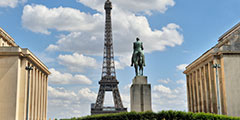The Trocadéro square was created in 1869 on the Chaillot Hill. Its name comes from an 1823 French military victory in Spain. It became a peace symbol thanks to the 1937 International Exhibition, which took place in Paris.
In the dark 1930s period, known for its unprecedented economic crisis and the rise of totalitarian regimes, an International Exhibition on “Arts and Techniques in modern life” was organised in Paris in 1937. The Trocadéro site and the Champ de Mars were chosen to host it. The exhibition aimed to be a place where technical, economic and intellectual exchanges could take place, in order to favour peace. Nevertheless, the rise of perils was even visible in the Trocadéro gardens, where the striking pavilions of the Nazi Germany and the Stalinist USSR were built face to face.
The Peace pavilion stood on the Trocadéro square. Its design had been chosen by the International Peace Campaign (RUP), an organisation gathering pacifists from various countries and of various perspectives. Its co-chair was Pierre Cot, the Air Minister of the Blum government. This pavilion showed educational exhibitions about the cost of wars, the League of Nations and its work for peace, and the then ongoing Spanish Civil War. In the centre of the pavilion, a peace column made by Albert Laprade and Léon Bazin rose. It was 50 meters high and covered with sculpted olive branches, a symbol of peace. The organisers of the exhibition wanted the column to become “a permanent and significant monument of better times”, but it did not outlive the exhibition.
In its place, an equestrian statue of Marshall Foch († 1929), one of the French military leaders of the First World War, was inaugurated on November 11th, 1951 by President Vincent Auriol. In 1956, a Monument dedicated to the French army of 1914-1918, made by sculptor Paul Landowski, was set up on one of the edges of the square, against a wall of the Passy graveyard. Eventually, in 1978, “and of November 11th” was added to the name of the square: it is the anniversary date of the First World War armistice.
Thus, this square, where the 1930s pacifists wanted to counter war threats and celebrate peace, was turned into a place of memory for the First World War in the 4th and 5th Republics, while the memory of the pavilion and the peace column has been forgotten. It was gone with the pacifism of this period, which was criticised after the Second World War.






 7 minutes
7 minutes